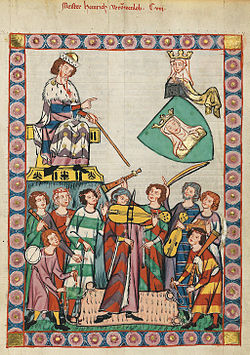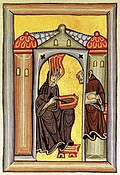Medieval music
Medieval music is music from the Middle Ages, a long period from about 400 AD to 1400 AD. This music was rarely written down, so historians do not know a great deal about it. However, they do know that medieval people used music both for entertainment and in their religious practice.
Troubadours and Trouvères
In medieval Europe, troubadours (called minstrels in England and minnesinger in Germany) were groups of entertainers who earned money by singing and playing musical instruments. They wrote their own songs, and occasionally they wrote down the lyrics, but they never wrote down the tunes. For this reason, we do not know what minstrels' songs sounded like.
The round Sumer is icumen in is a famous minstrel song that did have its lyrics written down by a monk. At the time, monks could often read and write.
Walther von der Vogelweide was a famous minnesinger in Germany.
Roles
Some minstrels traveled around the countryside. They often went to big houses and entertained the rich people who lived there. Troubadours would go from town to town playing love songs.
Other minstrels worked for a single master and would accompany them on journeys to battles. Minstrels also sang at important ceremonies like knightings.
Minstrels were poets and musicians, because they made up their own words and tunes. They wrote and sang ballads: long songs which told stories. Some told people about what was happening in the world. Others were made up and talked about love or mythology.
Richard the Lionheart
Richard the Lionheart was a keen musician. He wrote many songs in the style of the trouvères.
On the way back from a Crusade, he was captured by Leopold of Austria. The story goes that his attendant, Blondel, was looking for him everywhere. Then he heard Richard’s voice singing a song called Ja Nuns Hons Pris (I am no longer captive). By following Richard's voice, Blondel was able to find him.
Dances
Line dances and circle dances were the two main types of dance in medieval times.
The farandole is one example of a line dance. It was a bit like a modern conga, with people following a leader in a line.
The bransle was a round dance or circle dance. The word “bransle” comes from the French word “branler” (“to sway”). It is pronounced 'Brawl'.
The basse dance and estampie were other medieval dances.
Instruments
Instruments could be divided into quiet ones which were used indoors, and loud ones which were used outside. The recorder was a very popular indoor instrument. So were the psaltery and the harp (which looked like a small modern Welsh harp).
The bagpipes were loud instruments for outside. They were used for dancing. They were not as loud as modern Scottish bagpipes. They were more like Northumbrian pipes or the French musettes. There was also the hurdy-gurdy, which was played by turning a handle. Pipe and tabor were used for Morris dancing.
Many medieval plucked string instruments, like the lute and mandolin, were similar to a modern guitar. The dulcimer and zither had strings which were hit with sticks. These are still popular in Eastern Europe today. There were also “fiddles” (vielle) and trombones (called sackbut).
It was believed that if you were entertained with music while you are eating it would help you digest your food and help keep your heart healthy. And people believed that you will not get fat even if you scoffed down a load of food. Also eating food while having people dancing for you was believed to have made you fit.
Church music
Church music was very important. The mass was the main form of church music. It used the five parts of the mass Ordinary (the Eucharist service): Kyrie, Gloria, Credo, Sanctus and Agnus Dei. The priests in the churches wanted church music to be serious. They did not want it to become popular. They thought that if people enjoyed it too much they would forget about worshipping God. Religious plays had become very popular. They told stories from the Bible. However, the church leaders banned them, so they were performed in the streets and squares of the towns.
Instruments were also banned in church. The church leaders thought that they belonged to the devil. Only singing was allowed. Gradually, however, the organ started to be allowed in church. It helped people to sing. Some organs were very tiny. They were called portative organs. The large organs that were fixed in place were called “positives”. Bells were also used in church. They looked like our sleigh bells.
Medieval music was based on plainsong. This was a melody which sounded quite free in rhythm. Composers started adding a second part to the melody as an accompaniment. This was called organum. Sometimes it just simply followed the main tune a fourth or fifth below. This was called “parallel organum”. In the 12th and 13th centuries the original plainsong started to be put at the bottom. It became known as the cantus firmus (the “firm tune”). Sometimes antiphony was used. The simplest form of antiphony is when a leader sings something and a group (the choir) sing something back.
The type of plainchant that evolved was called Gregorian chant. By the 13th century all other types of chant had been forgotten in Western Europe.
Carols became popular at this time. At first a carol was a dancing song, but often these popular songs became used for songs for particular seasons or festivals. In later periods these developed into Christmas carols as we know them.
People often went around in groups, particularly at Christmas, singing at the houses of rich people. This was called Wassailing. The word means “being of good cheer” (i.e. “happy”). The Boar’s Head is a well-known medieval carol.
Mummers were groups of people who performed religious plays. They were travelling entertainers. They normally wore masks so that people did not know who they were.
Written music
There are not many musical manuscripts which have survived from the Middle Ages. Most of them are religious music. They were often written using a system called neumes. The pitch (music) of the music is shown by the neumes, but the rhythms were not very clear. Gradually the system of writing music we know today was evolving. Philippe de Vitry was an important composer and music theorist. He developed ways of writing rhythms.
High medieval music (1150-1300)
Most of the medieval music we know today belongs to the last part of the Middle Ages. There was a tradition known as the “Notre Dame school”. This music dates from around 1150 to 1250. It was the time that great cathedrals were being built in Gothic architecture. The cathedral of Notre Dame was a very famous example. The music of this time was called “Ars antique”. It used a system of rhythms called “rhythmic modes”. Gradually a new way of writing was used. This was called “Ars nova” (“New art”). The most famous composer of this time was Guillaume de Machaut. He developed a kind of composition called the isorhythmic motet. He wrote a lot of songs called chansons (the French word for “song”). Other types of song were called rondeau, ballade, and virelai.
Composers who were born at the end of the Middle Ages such as John Dunstable, Guillaume Dufay, and Gilles Binchois are often thought to belong to the next period in music history: the Renaissance period.
Medieval Music Media
A creature plays the vielle in the margins of the Hours of Charles the Noble, a book which contains 180 depictions of medieval instruments, probably more than any other book of hours.
A sample of Kýrie Eléison XI (Orbis Factor) from the Liber Usualis. The modern "neumes" on the staff above the text indicate the pitches of the melody. Listen to it interpreted.
Pérotin's Viderunt omnes, c. 13th century.
Hildegard of Bingen, one of the best-known composers of sacred monophony
Men playing the organistrum, from the Ourense Cathedral, Spain, 12th century
Christian and Muslim playing lutes in a miniature from Cantigas de Santa Maria of Alfonso X
Garin d'Apchier in a medieval manuscript, 13th century
Portrait of Walther von der Vogelweide









